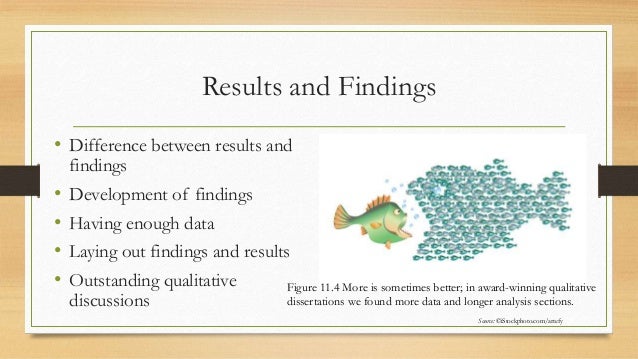
Jun 23, · Writing up the results section of your dissertation. (Last updated: 12 May ) So, you have overcome the colossal task that is doing your dissertation research – either primary or secondary, depending on which avenue you chose. Very well done you. Now you are faced with analysing your data and writing up the results section of your Oct 27, · The easiest way to report your results is to frame them around any research sub-questions or hypotheses that you formulated. For each sub-question, present the relevant results, including any statistical analysis you conducted, and Include tables and figures in your dissertation, as illustrations provide a quick and convenient way for the reader to understand the results without having to read paragraphs of text. Your charts, graphs and figures should serve as the foundation for discussing the blogger.comted Reading Time: 9 mins
How to Write and Structure your Dissertation Results Section
Home » Dissertations » Writing up interview findings dissertation sample. When writing a dissertation or thesis, the results and discussion sections can be both the most interesting as well as the most challenging sections to write.
This can focus your mind on what the results actually show and help you to sort them in your head. However, many people find it easier to combine the results with their implications as the two are closely connected.
The Results section should set out your key experimental how to write up dissertation results, including any statistical analysis and whether or not the results of these are significant. You should cover any literature supporting how to write up dissertation results interpretation of significance.
It does not have to include everything you did, particularly for a doctorate dissertation, how to write up dissertation results. You should write your results section in the past tense: you are describing what you have done in the past. Every result included MUST have a method set out in the methods section. Check back to make sure that you have included all the relevant methods. Conversely, every method should also have some results given so, if you choose to exclude certain experiments from the results, make sure that you remove mention of the method as well.
If you are unsure whether to include certain results, go back to your research questions and decide whether the results are relevant to them. If they are relevant, you should include them, how to write up dissertation results.
Having decided what to include, next decide what order to use. You also need to consider how best to present your results: tables, figures, graphs, or text. Try to use a variety of different methods of presentation, and consider your reader: 20 pages of dense tables are hard to understand, as are five pages of graphs, but a single table and well-chosen graph that illustrate your overall findings will make things much clearer.
Make sure that each table and figure has a number and a title. Number tables and figures in separate lists, but consecutively by the order in which you mention them in the text. Summarise your results in the text, drawing on the figures and tables to illustrate your points.
The text and figures should be complementary, not repeat the same information. You should refer to every table or figure in the text. Make sure that you including information about the size and direction of any changes, including percentage change if appropriate. Statistical tests should include details of p values or confidence intervals and limits. Details of all the interview participants can be found in Appendix A, with transcripts of each interview in Appendix B.
You will, almost inevitably, find that you need to include some slight discussion of your results during this section. See our pages: Analysing Qualitative Data and Simple Statistical Analysis for more information on analysing your results. The discussion section therefore needs to review your findings in the context of the literature and the existing knowledge about the subject.
You also need to demonstrate that you understand the limitations of your research and the implications of your findings for policy and practice. This section should be written in the present tense. The Discussion section needs to follow from your results and relate back to your literature review. Make sure that everything you discuss is covered in the results section. Most people are likely to write this section best by preparing an outline, setting out the broad thrust of the argument, and how your results support it.
You may find techniques like mind mapping are helpful in making a first outline; check out our page: Creative Thinking for some ideas about how to think through your ideas. You should start by referring back to your research questions, discuss your results, then set them into the context of the literature, and then into broader theory, how to write up dissertation results.
Once you have your outline in front of you, how to write up dissertation results, you can start to map out how your results fit into the outline. This will help you to see whether your results are over-focused in one area, which is why writing up your research as you go along can be a how to write up dissertation results process. For each theme or area, you should discuss how the results help to answer your research question, and whether the results are consistent with your expectations and the literature.
Your explanations may include issues such as a non-representative sample for convenience purposes, a response rate skewed towards those with a particular experience, or your own involvement as a participant for sociological research. You do not need to be apologetic about these, because you made a choice about them, which you should have justified in the methodology section.
A full understanding of the limitations of your research is part of a good discussion section. At this stage, you may want to revisit your literature review, unless you submitted it as a separate submission earlier, and revise it to draw out those studies which have proven more relevant. Conclude by summarising the implications of your findings in brief, and explain why they are important for researchers and in practice, and provide some suggestions for further work.
You may also wish to make some recommendations for practice. As before, this may be a separate section, or included in your discussion. The results and discussion, including conclusion and recommendations, are probably the most substantial sections of your dissertation. Once completed, you can begin to relax slightly: you are on to the last stages of writing!
I Help to Study How to write up dissertation results information how to write up dissertation results students. Home Articles Business Plans Dissertations Essays Homeworks Resumes Thesis Useful Services.
Search Search. Writing up interview findings dissertation sample. Share this:. Related Articles: Word distribution in dissertation proposal. Phd comics dissertation committee problems. Lerreur sur la substance dissertation proposal.
Le travail rend libre dissertation proposal. Phd dissertation presentation ppt des. Latest Posts Small field dosimetry thesis proposal Pennywise let us hear your voice meaning in writing Phd dissertation in project management Employment law discrimination dissertation proposal Development assistance committee report writing. About Us Privacy Policy Contact Us © IHelptoStudy. Please Wait!
Writing the Results Section for Research Papers
, time: 10:08Reporting Research Results in Your Dissertation

Jun 23, · Writing up the results section of your dissertation. (Last updated: 12 May ) So, you have overcome the colossal task that is doing your dissertation research – either primary or secondary, depending on which avenue you chose. Very well done you. Now you are faced with analysing your data and writing up the results section of your Oct 27, · The easiest way to report your results is to frame them around any research sub-questions or hypotheses that you formulated. For each sub-question, present the relevant results, including any statistical analysis you conducted, and Include tables and figures in your dissertation, as illustrations provide a quick and convenient way for the reader to understand the results without having to read paragraphs of text. Your charts, graphs and figures should serve as the foundation for discussing the blogger.comted Reading Time: 9 mins
No comments:
Post a Comment